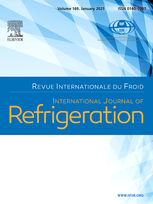
IIR document
Pressure drop and flashing mechanisms in refrigerant expansion devices.
Author(s) : SIMÕES-MOREIRA J. R., BULLARD C. W.
Type of article: Article, IJR article
Summary
This article examines a novel pressure drop mechanism as well as flow choking conditions that determine mass flow rate in refrigerant expansion devices. In this study, an ideal situation was considered as being that in which an expansion device such as a short tube orifice or a thermostatic expansion valve is modelled as an ideal isentropic nozzle. In addition, a liquid with a certain initial degree of superheat is first expanded in the converging nozzle down to the exit section without any phase transition. At the exit section where the metastable liquid jet flashes to produce complex axisymmetric two-phase flow, a shock wave may terminate the overall expansion process. The model presented here was based on experimental observations in short nozzles, where the metastable liquid in the central core undergoes a sudden phase transition in the interfacial region, giving rise to a high-speed two-phase flow. A simple 1-D analysis of the radial evaporation wave based on the theory of discontinuities from gas dynamics leads to the Chapman-Jouguet (C-J) solution. Flow choking issues were examined and numerical examples are presented for three common refrigerants: R134a, R22, and R600a. Results suggest that the evaporation wave may be the flow controlling mechanism in these devices.
Available documents
Format PDF
Pages: 840-848
Available
Public price
20 €
Member price*
Free
* Best rate depending on membership category (see the detailed benefits of individual and corporate memberships).
Details
- Original title: Pressure drop and flashing mechanisms in refrigerant expansion devices.
- Record ID : 2004-1568
- Languages: English
- Source: International Journal of Refrigeration - Revue Internationale du Froid - vol. 26 - n. 7
- Publication date: 2003/11
Links
See other articles in this issue (12)
See the source
Indexing
-
Les mélanges du froid.
- Author(s) : COURTY J. M., KIERLIK E.
- Date : 2002/11/26
- Languages : French
- Source: www.pourlascience.com - 3 p.
View record
-
Planung und Betriebsverfolgung von Ammoniak/Sol...
- Author(s) : BLINDAUER C., RIESENBECK G. van
- Date : 1999/10
- Languages : German
- Source: KI Luft Kältetech. - n. 10
View record
-
REFRIGERANTS IN HEAT EXCHANGE FOR REFRIGERATION.
- Author(s) : MIARI D.
- Date : 1984
- Languages : Italian
- Source: Rev. Ferment. Ind. aliment. - vol. 23 - n. 216
View record
-
Estimation des pertes de pression intratubulair...
- Author(s) : VRINAT G.
- Date : 2001/04
- Languages : French
- Source: Rev. gén. Froid - vol. 91 - n. 1012
View record
-
Indirekte Systeme für Supermarktkälteanlagen.
- Author(s) : BERGER U.
- Date : 1998/01
- Languages : German
- Source: KI Luft Kältetech. - vol. 34 - n. 1
View record
